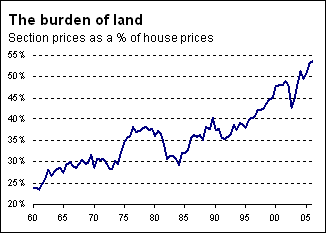Blame it on the boomers
The affordability of housing is currently a hot topic. But even with house prices so high, over 102,000 properties changed hands last year — implying that housing is still affordable for some. Simple economics tells us that prices would not keep rising if they weren’t being driven by demand.
Why has the boom kept going for so long? Migration is no longer providing the same impetus that it did a few years ago. Population growth halved between mid-2003 and June 2005 and has changed little since then. But the annual build rate remains above historical averages and, if anything, suggests we should be seeing an oversupply of housing starting to develop.
Persistently good economic growth between 2001 and 2005 has fuelled increases in incomes and virtually eliminated unemployment. High levels of job security have made people confident about taking on more debt to purchase property. To some extent, this appetite for debt has been facilitated by relatively attractive interest rates. New Zealanders are willing to borrow at 8%pa, and foreigners have been more than happy to lend us money at rates well in excess of what they can secure back in Europe or Japan.
Zoning restrictions have been a factor underpinning land prices, but this is not a trend that has suddenly developed over the last five years. Back in 1960, an average section was worth around 25% of an average house with land. That figure has steadily risen to 53%. In other words, if you’re thinking of buying a property, you’re probably paying more for the land than the structure on top of it.

The surge in house prices has not been unique to New Zealand, with similar phenomena occurring in the UK, Australia, and the US, to name a few. When investing in stocks fell out of favour in 2001, foreigners were quick to take advantage of New Zealand’s cheap prime coastal property — especially with the exchange rate closer to US40c than US70c. And by 2004, as the housing market across the Tasman cooled, yields on rental property in provincial towns such as Wanganui were attractive for Australian investors discouraged by the miniscule returns on offer in Sydney and Melbourne.
Baby boomers across the Western world are now saving as fast as possible for retirement, which helps explain the global nature of the house price boom. New Zealanders’ love affair with owning investment property is well documented, and the tax treatment of rental property (accelerated depreciation rates, LAQCs, and the lack of any capital gains tax) has ensured it remains one of the most popular savings vehicles.
It also explains why momentum in the housing market has kept on rolling — even though economic growth has slowed and interest rates have risen, saving for retirement will continue en masse for the next 5-10 years.
With rental yields in New Zealand now at historically low levels, and housing affordability measures at their worst for decades, it is implausible that house price inflation will continue at the rates seen over the last five years. But with the largest swathe of baby boomers not reaching retirement age until around 2015, a sudden reversal in prices is not on the cards either. Most property investors are likely to maintain their holdings for another decade before cashing up, and there are bound to be other purchasers on the fringe of the market hoping the gains of the last few years are repeated.
The government’s angst about housing affordability is a response to a relatively short-term problem, and risks causing a repeat of the 1970s housing crash. When all the baby boomers left home early that decade, there were not enough houses to accommodate them all. Subsequent high levels of state house building combined with an economic downturn to leave the real estate market grossly oversupplied. As a result, house prices, in inflation-adjusted terms, collapsed.
For those readers worried about a correction in house prices in ten years’ time as everybody tries to cash up at once, the news is not all bad. By 2015, the baby boomers’ kids will be in their early 30s and looking to settle down. As long as your investment property would appeal to someone as a first home, you should be able to find a buyer out there.
Putting aside policy-related risks, a soft landing for house prices still looks to be on the cards. While current demand for residential property is not due to population growth (the most fundamental of drivers), neither is it simply a speculative bubble. New Zealanders have simply responded to the incentive structures in place when choosing how to save for their retirement.

















